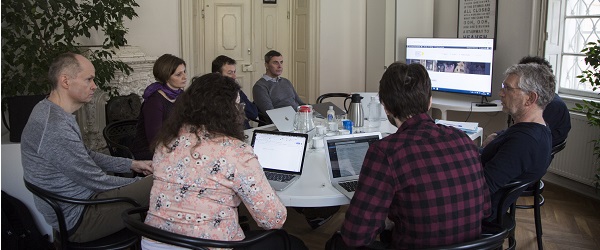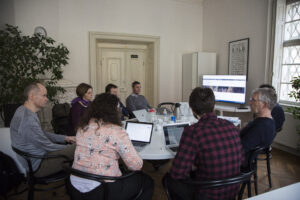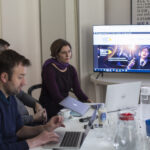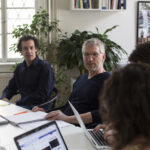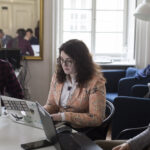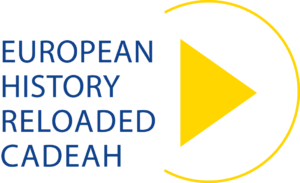On February 1, the members of the European History Reloaded: Curation and Appropriation of Digital Audiovisual Heritage (CADEAH) project met at the Institute of Contemporary History, Prague. CADEAH is a new project that researches the online circulation and appropriation of audiovisual heritage using an integrated and interdisciplinary approach. Led by Utrecht University (UU), Umeå University (UMU), and the Institute of Contemporary History (USD), the project brings together tracking and tracing technologies, critical cultural analysis, and ethnographic fieldwork to present a holistic investigation on the major questions about the use and reuse of the massive body of audiovisual heritage now digitally accessible to online users.
The meeting was the second face-to-face meeting of the main project members, after the successful kickoff in Utrecht at the end of September, and focused on further developing the content of the overall project. Present were Pelle Snickars and Roger Mähler of Umeå University, Adéla Gjuričová, Petr Roubal, and Vítězslav Sommer of the Institute of Contemporary History, Eggo Müller and Abby Waysdorf of Utrecht University, and Johan Oomen of the Netherlands Institute for Sound and Vision. Each work package gave an overview of their plans and recent discoveries, and discussed how they might work with the others.
From Umeå, where the Humlab is investigating the technical possibilities for tracking and tracing audiovisual digital heritage, Pelle Snickars and Roger Mähler discussed their experiments with different methods of fingerprinting and identifying archival content. These focused around two areas: the potential of working with Youtube and its content ID program, and developing on the hashing algorithm used by Videorooter, both of which have potential for the aims of the project. There was also a consideration of working more closely with specific archives, which will be pursued in the upcoming months, as well as looking at some potential academic questions around competing claims to archival material in the age of monetization.
The meeting then turned to look at potential case studies for the project, brought by USD and UU. The USD researchers discussed the rise of political remix videos in the Czech context, where international popular culture as well as Czech history are used to discuss and critique local topics and issues. These can range from remixing the English-language flubs of a particularly pompous politician to film mashups to conspiracy theories around the Velvet Revolution, with the upcoming anniversary of that event expected to inspire even more. However, it wasn’t all deconstruction – Vítězslav Sommer also showed the group videos of speeches by Jan Werich set to music that viewers suggest connecting to a “deeper truth,” and that these “lessons from the past” can also be used as a way to positively construct contemporary ideas of the nation.
From there, the Utrecht team, working from the perspective of digital ethnography, introduced their ideas around different contexts of archival reuse. The first discussion was over War Aesthetics videos, where videos of war and militaries are treated and set to vaporwave music, with no clear message about the conflict itself. Following this, Abby Waysdorf also showed some Eurovision reaction videos – vloggers reacting to Eurovision songs and acts of the past. While very different, the goal with showing these was to demonstrate the breadth of the topic, and to highlight her intention to look at the context of the re-use of archival material – what are the networks that make it possible? What do producers think they’re doing, and what do audiences think they’re watching? The War Aesthetics videos were found to be particularly intriguing in that regard.
Following lunch, the team discussed upcoming deliverables for the project – keep an eye out for a planned documentary from the USD team and a virtual exhibition from UU, alongside upcoming research papers and presentations.
All in all, it was a productive and invigorating meeting, indicating the overall potential of the CADEAH project. If you would like to know more about what we do or have ideas for us, please visit our website at www.cadeah.eu.

